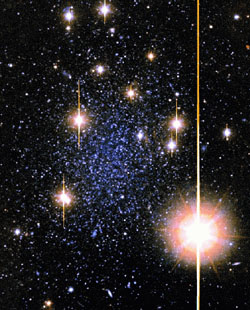![[Currents header graphic]](/homeart/currents_header.gif)
![[Currents header graphic]](/homeart/currents_header.gif)
January 11, 1999
By Tim Stephens
UCSC astronomers have characterized two nearby dwarf galaxies discovered in 1998, identifying them as members of the Local Group of galaxies that includes the Milky Way. Eva Grebel, a Hubble postdoctoral fellow, and Raja Guhathakurta, an associate professor of astronomy and astrophysics, confirmed earlier suspicions that the newly discovered galaxies are companions of the Andromeda spiral galaxy.

|
|
The Pegasus dwarf galaxy (center) is a companion of the Andromeda spiral galaxy, approximately 2.5 million light-years from the sun. (more photos)
|
The researchers also characterized the ages and chemical compositions of the stars in the two dwarf galaxies. They presented their findings last week at the American Astronomical Society meeting in Austin, Texas.
Studying these relatively small, dim galaxies provides valuable information about the Local Group of galaxies and contributes to astronomers' understanding of how galaxies evolve, said Guhathakurta. Dwarf galaxies are thought to serve as building blocks from which larger galaxies are assembled.
The Local Group is a small collection of galaxies consisting of three large spiral galaxies (the Milky Way, Andromeda, and M33) plus many smaller satellite galaxies. The satellite galaxies have low masses and low luminosities, which makes it difficult to detect them, and many were only discovered recently.
The two galaxies described by Grebel and Guhathakurta were discovered last year by a team of astronomers in Russia and Ukraine, who named them Pegasus dwarf (Peg dSph) and Cassiopeia dwarf (Cas dSph) after their parent constellations. Independently, an American group based at Kitt Peak National Observatory in Arizona found two dwarf galaxies in the same region, which they named Andromeda V (And V) and Andromeda VI (And VI) due to their proximity to the Andromeda galaxy. And VI turned out to be the same galaxy as Peg dSph.
Grebel and Guhathakurta observed Peg dSph and Cas dSph with the Keck II 10-meter (400-inch) telescope on Mauna Kea, Hawaii. They used the Keck Low Resolution Imaging Spectrograph (LRIS) to obtain images of the galaxies, estimate their distances, and analyze stellar luminosities and temperatures. The researchers classified the two galaxies as dwarf spheroidal galaxies, the dimmest and least massive type of galaxy known. The galaxies are around 800 kiloparsecs (about 2.6 million light-years) from the Sun, putting them in the neighborhood of Andromeda.
Andromeda (also known as M31) is the most massive galaxy in the Local Group and is visible to the naked eye as a faint point of light in the night sky. Peg dSph and Cas dSph are farther from Andromeda than its other known companion galaxies, but are probably still bound to it by gravity, said Guhathakurta.
By analyzing the light emitted by stars in the two galaxies, the researchers showed that they do not contain any young, massive stars and show no traces of recent star formation. Instead, these galaxies are dominated by very old stars, mostly older than 10 billion years. This, plus the shapes of the galaxies, led to their classification as dwarf spheroidal galaxies, said Grebel, who is now at the University of Washington in Seattle.
"There are basically two types of dwarf galaxies: The irregular type tends to contain a lot of gas and usually shows ongoing star formation, whereas the spheroidal type tends to be gas-poor, lower in mass and luminosity, and quiescent," Grebel said.
Grebel and Guhathakurta's analysis also showed that the chemical composition of these galaxies is relatively low in heavy elements. This "metallicity" estimate is an indicator of a galaxy's evolutionary history, said Grebel. Stars form heavy elements (metals) through fusion reactions in their cores, and stellar winds or supernova explosions of massive stars release these elements into the surrounding medium, she explained. Massive galaxies that contain a lot of star-forming material (gas) continue to form new stars and become increasingly metal-rich. In low-mass galaxies, however, the gas supply becomes depleted and star formation stops much earlier.
"Metal-poor galaxies usually have had only a few generations of star-formation episodes," Grebel said.
The gravitational field of the massive Andromeda galaxy may have stripped the star-forming gases from these companion galaxies, said Guhathakurta. The absence of young and intermediate-age stars in Peg dSph and Cas dSph is somewhat surprising, however, because they are so far away from Andromeda, he noted. Among the dwarf spheroidal companion galaxies of the Milky Way, those at comparable distances do contain some intermediate-age stars.
"This suggests that the Andromeda galaxy is more massive than the Milky Way, so its gravitational influence extends out to a greater distance," Guhathakurta said.
Grebel and Guhathakurta undertook this study in preparation for a more extensive spectroscopic survey of stars in Andromeda's companion galaxies, which they plan to conduct at the Keck Observatory in 1999.